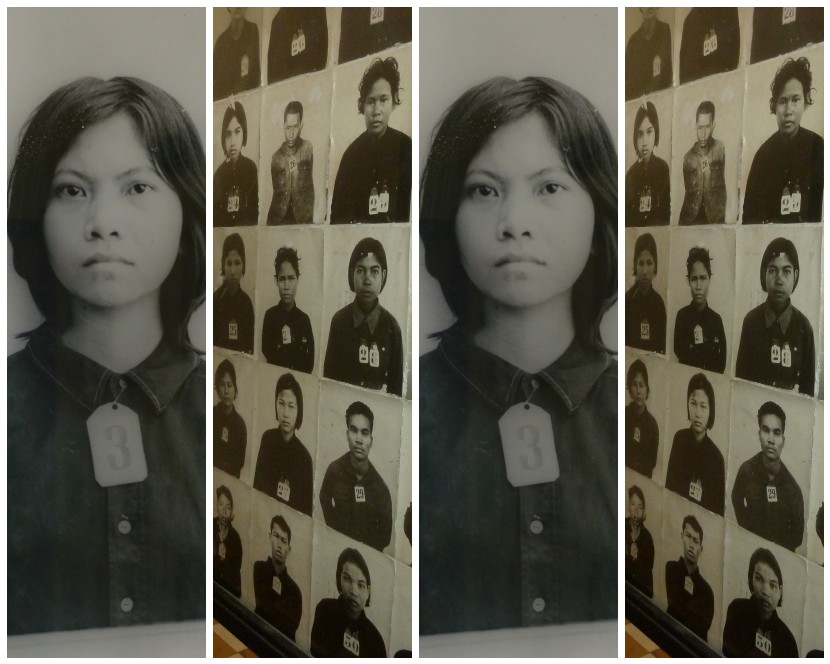Between 1975 and 1979, an estimated 2 million Cambodians — 20 percent of the country’s population at the time — died at the hands of the Khmer Rouge regime. Some 17,000 victims were held in the regime’s most notorious prison, a former high school known as Tuol Sleng (“Hill of the Poisonous Trees”) or S-21. Today, the building is called the Tuol Sleng Genocide Museum. Tucked into a busy neighborhood in central Phnom Penh, it’s a carefully preserved nightmare.
Visitors walk through blandly macabre classrooms-turned-torture-chambers, and into tiny brick-and-wood cells where prisoners were held for weeks and months. But their silence is heaviest before the rows and rows of faces — the thousands of black-and-white mugshots taken by the maniacally efficient wardens of Tuol Sleng.
When I visited Tuol Sleng during a reporting trip earlier this year, I took pictures of some of the faces, trying — like everyone around me, I imagine — to see the people within the overwhelming numbers. Later, when I looked at my camera, I saw I’d taken several photos of the same young woman. She was beautiful, with clear eyes, a proud posture and a stylish haircut. But even more striking than her beauty was the way she’d raised one eyebrow in what looked like defiance, and set her mouth in determination instead of fear. She must have known her fate — only seven people are thought to have survived Tuol Sleng — and she’d chosen to meet it with this face.
Who was she? It didn’t take long to find out.
Hout Bophana was born in rural northwestern Cambodia, and came of age in a nation newly independent from France. At 16, she fell in love and became engaged to a distant cousin, Ly Sitha. Before they could marry, their lives changed forever: the king was overthrown in a coup, Cambodia descended into a proxy war, and Sitha became a monk to avoid the draft. Bophana and her sisters escaped to a provincial city, where Bophana was raped by a Cambodian soldier, became pregnant and gave birth to a son. She then moved to the capitol, where she managed to find work in a foreign-run charity.
In the spring of 1975, the Khmer Rouge gained control of Phnom Penh, and Bophana’s world crumbled again. She was a literate, sophisticated woman, but under the Khmer Rouge her education marked her for persecution. Along with hundreds of thousands of others, she was marched out of the city, separated from her family, and forced into hard labor in the fields. She was well on her way to dying of starvation when Sitha suddenly reappeared — not in monk’s robes, but in the black pajamas of the Khmer Rouge.
Sitha, now called Comrade Deth, had joined the revolution but had not forgotten Bophana, and he had used his position to trace her. He told the doubtful villagers that Bophana was his wife, and gave her food and medical treatment. But she wasn’t safe, and neither was he.
When Sitha had to return to Phnom Penh, he and Bophana wrote each other desperate love letters. Knowing the risks, she sometimes signed herself “Flower of Dangerous Love.” Eventually, their romance was exposed: Sitha was arrested for hiding his education (the letters were written in French, English and Khmer) and for the far more serious offense of putting love before revolution. Sitha was executed, and Bophana was sent to Tuol Sleng, where she was interrogated, tortured, and, finally, executed and buried in a mass grave.
The story of Bophana has been told by journalist Elizabeth Becker, both in a short book and in When the War Was Over, her magisterial account of the Khmer Rouge and its aftermath. (Her account was the basis for the 1996 film Bophana: A Cambodian Tragedy.) In When the Was Was Over, Becker describes the deeply personal repression practiced by the regime:
[T]he Khmer Rouge were threatened by all expressions of love — between husband and wife, parents and children, friends and colleagues. Everyone had to renounce personal intimacies … By writing to each other, Deth and Bophana had refused to live a solitary, isolated and emotionally barren life. That was perhaps Bophana’s greatest crime.
The Khmer Rouge killed millions of children, parents, and lovers, and too many of them remain anonymous. The story of Deth and Bophana is one of thousands like it, but it’s one of the very few that survives in such detail — through their letters, her forced confessions, and the heart-stopping photo displayed in Tuol Sleng. That one woman must stand witness for so many is a tragedy. That she can, and does, is her final triumph.

I remember visiting Phnom Penh 10 years ago. I was struck by how few old people lived there.